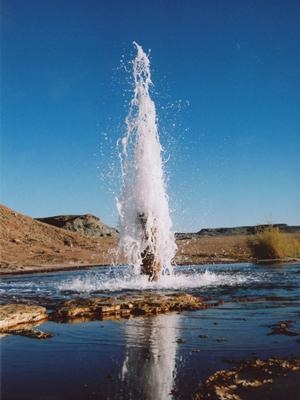Jul 29 2016
Study of natural-occurring 100,000 year-old CO2 reservoirs shows no significant corroding of 'cap rock', suggesting the greenhouse gas hasn't leaked back out - one of the main concerns with greenhouse gas reduction proposal of carbon capture and storage.
 Image shows a cold water geyser driven by carbon dioxide erupting from an unplugged oil exploration well drilled in 1936 into a natural CO2 reservoir in Utah.(Credit: Professor Mike Bickle)
Image shows a cold water geyser driven by carbon dioxide erupting from an unplugged oil exploration well drilled in 1936 into a natural CO2 reservoir in Utah.(Credit: Professor Mike Bickle)
New research shows that natural accumulations of carbon dioxide (CO2) that have been trapped underground for around 100,000 years have not significantly corroded the rocks above, suggesting that storing CO2 in reservoirs deep underground is much safer and more predictable over long periods of time than previously thought.
These findings, published today in the journal Nature Communications, demonstrate the viability of a process called carbon capture and storage (CCS) as a solution to reducing carbon emissions from coal and gas-fired power stations, say researchers.
CCS involves capturing the carbon dioxide produced at power stations, compressing it, and pumping it into reservoirs in the rock more than a kilometre underground.
The CO2 must remain buried for at least 10,000 years to avoid the impacts on climate. One concern is that the dilute acid, formed when the stored CO2 dissolves in water present in the reservoir rocks, might corrode the rocks above and let the CO2 escape upwards.
By studying a natural reservoir in Utah, USA, where CO2 released from deeper formations has been trapped for around 100,000 years, a Cambridge-led research team has now shown that CO2 can be securely stored underground for far longer than the 10,000 years needed to avoid climatic impacts.
Their new study shows that the critical component in geological carbon storage, the relatively impermeable layer of "cap rock" that retains the CO2, can resist corrosion from CO2-saturated water for at least 100,000 years.
"Carbon capture and storage is seen as essential technology if the UK is to meet its climate change targets," says lead author Professor Mike Bickle, Director of the Cambridge Centre for Carbon Capture and Storage at the University of Cambridge.
"A major obstacle to the implementation of CCS is the uncertainty over the long-term fate of the CO2 which impacts regulation, insurance, and who assumes the responsibility for maintaining CO2 storage sites. Our study demonstrates that geological carbon storage can be safe and predictable over many hundreds of thousands of years."
The key component in the safety of geological storage of CO2 is an impermeable cap rock over the porous reservoir in which the CO2 is stored. Although the CO2 will be injected as a dense fluid, it is still less dense than the brines originally filling the pores in the reservoir sandstones, and will rise until trapped by the relatively impermeable cap rocks.
"Some earlier studies, using computer simulations and laboratory experiments, have suggested that these cap rocks might be progressively corroded by the CO2-charged brines, formed as CO2 dissolves, creating weaker and more permeable layers of rock several metres thick and jeopardising the secure retention of the CO2," explains Bickle.
"However, these studies were either carried out in the laboratory over short timescales or based on theoretical models. Predicting the behaviour of CO2 stored underground is best achieved by studying natural CO2 accumulations that have been retained for periods comparable to those needed for effective storage."
To better understand these effects, this study, funded by the UK Natural Environment Research Council and the UK Department of Energy and Climate Change, examined a natural reservoir where large natural pockets of CO2 have been trapped in sedimentary rocks for hundreds of thousands of years. Sponsored by Shell, the team drilled deep down below the surface into one of these natural CO2 reservoirs to recover samples of the rock layers and the fluids confined in the rock pores.
The team studied the corrosion of the minerals comprising the rock by the acidic carbonated water, and how this has affected the ability of the cap rock to act as an effective trap over geological periods of time. Their analysis studied the mineralogy and geochemistry of cap rock and included bombarding samples of the rock with neutrons at a facility in Germany to better understand any changes that may have occurred in the pore structure and permeability of the cap rock.
They found that the CO2 had very little impact on corrosion of the minerals in the cap rock, with corrosion limited to a layer only 7cm thick. This is considerably less than the amount of corrosion predicted in some earlier studies, which suggested that this layer might be many metres thick.
The researchers also used computer simulations, calibrated with data collected from the rock samples, to show that this layer took at least 100,000 years to form, an age consistent with how long the site is known to have contained CO2.
The research demonstrates that the natural resistance of the cap rock minerals to the acidic carbonated waters makes burying CO2 underground a far more predictable and secure process than previously estimated.
"With careful evaluation, burying carbon dioxide underground will prove very much safer than emitting CO2 directly to the atmosphere," says Bickle.